John Janaro's Blog, page 88
October 25, 2021
Asia's Greatness, Tragedy, and Hope
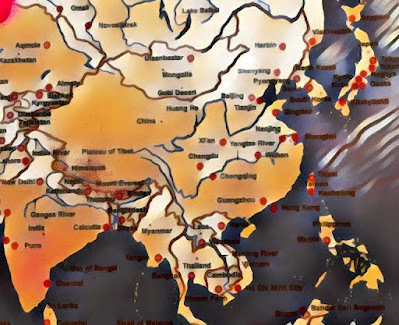 My ongoing East Asian Studies Project research has led me to a deeper appreciation of the historical and social forms of various non-Christian (often existentially “pre-Christian”) societies.
My ongoing East Asian Studies Project research has led me to a deeper appreciation of the historical and social forms of various non-Christian (often existentially “pre-Christian”) societies. So much can be said for the millennia of history journeyed through by countless peoples with their great efforts, ardent questions, and intrepid search for truth. Above all, we know that ultimately we will marvel at the many secret ways of grace by which the Mystery of God has guided a significant portion of the human race in the Divine plan of redemption and made possible their salvation, even though these great peoples were for a long time distant in earthly space and explicit knowledge of the events of the life, death, and resurrection of Jesus, who is the only Savior of the world and of each person.
Regarding the salvation of the nations, Christians can have great confidence in God's infinite power and infinite mercy, while not losing any of our ardor for evangelization and our sense of responsibility to witness to Jesus and His Church in every place, because (as John Paul II said in his first encyclical) every human person "has the right" to know the One for whom they have been made, the One who has redeemed them and who loves them and gives ultimate meaning to their lives.
Having said this, we must note with gratitude the stunning beauty and great human achievements, splendid poetry, literature, wisdom, and many beautiful religious traditions in these cultures that for so long were virtually inaccessible to the civilizations of those places commonly known as "the West" and "the Near East" (and vice versa). The advent of the global epoch has engendered global encounters, but thus far they have been more belligerent than fruitful, involving too much the imposition of the modern West's colonial and technocratic power. It is time for the whole world to be enriched by the great ancient human heritages of Asia (which we Westerners still know too little about).
This is one reason why I feel compelled to pursue this study in the autumn of my own life. It is important for the future of humanity that we continue to build strong bridges of understanding and compassion between West and East. Nevertheless, it is also important to try to understand the problems and ambivalence that have grown from within East Asian cultures themselves (because, like all human cultures, they are flawed and profoundly strained by the mysterious incoherence of the human condition in this world).
From what I am learning, it seems that Asia's rich achievements and insights still coexist with - and are often partly tangled up with - other deeply entrenched, centuries-old violent structures and attitudes of oppression, intractable ethnic conflicts, methodical atrocities, harmful superstitions, and numerous forms of depersonalization that have been accepted for longer than anyone can remember. Certain modes of human existential impoverishment have been integrated into life, even resigned to with a poignant sense of the inescapable tragedy of life, but accepted (with sorrow) as inevitable and impossible to change. East Asian societies are paralyzed in some of these ways, sometimes with ruthless results, and other times with a sense of tragic nobility, restraint, and inner coherence that has elements of great courage and a powerful sense of moral responsibility - but also an often desperate longing for an apparently elusive forgiveness.
Sometimes Asian cultures seem to have less awareness of the dignity of the individual human person, or are considered to be "fatalistic" in the face of human suffering. This is an oversimplification, of course. A blog post, however, must paint in broad strokes, remembering that pondering these issues here is always very provisional. What occurs to me, however, is that Asian societies have a keen sense of the fragility of all things, and of a world so easily broken by human weakness, vanity, failure, and stubbornness. Experience and reflection on human life has long taken place there in a context where the possibility for forgiveness has appeared distant, if not indeed "beyond the horizon" of hope.
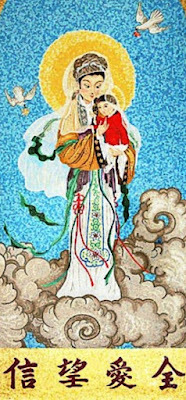
This points to a way that a genuine inculturated evangelization may well transfigure Asia's precious heritages, healing wounds and bringing to a new level all of the great goods therein so that they might shine with a fresh brightness of light such as we all need now and in times to come. East Asia needs to experience (within the real personal and social lives of its peoples) the kind of transforming forgiveness that Jesus brings through the Gospel and the sacraments (even though - we must never forget - He is already at work in their hearts, in who-knows-what mysterious ways, to draw them into His merciful heart for their eternal salvation).
I'm talking about a real encounter with Jesus Christ among peoples and cultures. I'm not talking about an extrinsic imposition of a "Christian worldview" such as Westerners once aspired to cultivate. It will rightly be pointed out that many Christians have perpetrated even greater wars, hatred, and atrocities (even with institutional complicity), but we must remember that in so doing they have not represented Jesus Christ. Rather they have betrayed Him.
Whereas the power of the real Gospel - wherever it is proposed with genuine love and witness - always initiates and fosters great positive changes in the human attitudes and practices of the overall society (even if these developments are still far from perfect, still partial, or take time to mature in application, or are frequently violated - but with these violations also frequently, or at least eventually, denounced and reformed). The Gospel puts forth an ideal of what it means to be human that is continually renewed and keeps “pulling upward” on humanity even in the temporal history of this world.
I'm not engaging here in partisan religious flag-waving: Christians have a lot to be ashamed of, and a greater responsibility because they ought to know better in light of the great gift of explicit awareness of the Gospel. We need to repent, and remember that the Gospel has power not only to save us for eternity but also to “humanize” us more in this life, including the freeing up and fulfillment of our roots in diverse human cultures and traditions.
I have seen the beginning of this for East Asia through writing the stories of Asian converts from different times and places including China, Japan, Vietnam, and India. For example Takashi Nagai, in becoming Catholic, became more profoundly Japanese, and even attained the status of a symbol of his people's suffering - as he endured during his illness the devastation visited upon so many ordinary civilians by atomic (and conventional) aerial bombing at the end of the Second World War. I think also of Chinese converts like the late John C. H. Wu - so dynamically and “interiorly” Chinese and also so deeply Catholic. Wu could find analogies between the Tao and Saint Therese of Lisieux, discourse on Confucius, or on the poetry of the Tang dynasty, translate the Psalms into verse in classical Chinese style, and have a childlike intimacy with the saints of the Church.
Western colonialism was such a mess because even many of the missionaries weren’t adequately focused on true and vital conversions to Christianity; they also thought it necessary to make everyone into Western-style people (and “second class” Western-style people at that). We Christians have failed our Asian brothers and sisters in varying degrees, but it remains our fault. It is not the fault of “Christianity.” Chesterton was right. Christianity as the inspiration for a social ideal “hasn’t been ‘tried’ yet, really.” What I call “Christendom 1.0” was a deeply flawed piece of “software” (forgive the analogy) that eventually corrupted, yet a lot got accomplished insofar as it freed the Gospel to touch society.
Dare we hope, someday, for a “Christendom 2.0” that is drawn together by Jesus Christ in human solidarity, respect for freedom, human dignity, love for the poor and works of mercy? It would be personalist and communitarian, and founded on Christ’s presence through evangelical love - agape, caritas, especially “fraternal charity” (such as Jacques Maritain envisioned and tried to outline, in works such as Integral Humanism that profoundly influenced the vision of Vatican II). Perhaps rather than calling it “a New Christendom” we need another “less loaded” term, lest the powers of this world make the same mistake and think that evangelization is a tool for increasing and consolidating their grip on things and making themselves rich. (Though in the 21st century, one doubts that the powers of the world would care about or even comprehend such terms or the ideal they try to express. In any case, let us remember to care about these possibilities and pray for their realization.)
Anyway, I have lots of thoughts here, painted with a broad brush, and perhaps with no little foolishness.🙂 But my East Asian Studies Project continues, and I hope and pray that it will be fruitful in more ways than I will ever know in what's left of my own earthly life. If I can prompt other people to consider these realities more attentively, that alone would make my labors worthwhile.
October 22, 2021
Happy JP2 Day!
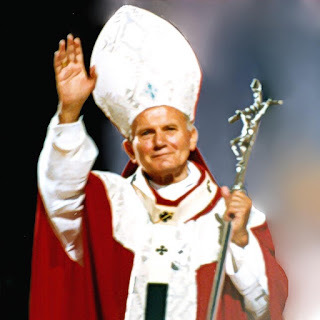 HAPPY JP2 DAY!
HAPPY JP2 DAY! Today is the memorial of Saint John Paul II (Pope from 1978-2005) who was a “witness to hope” for our generation, and for today and the future:
“Do not be afraid. Open wide the doors for Christ. To his saving power open the boundaries of States, economic and political systems, the vast fields of culture, civilization and development. Do not be afraid. Christ knows ‘what is in man’. He alone knows it. So often today man does not know what is within him, in the depths of his mind and heart. So often he is uncertain about the meaning of his life on this earth. He is assailed by doubt, a doubt which turns into despair. We ask you therefore, we beg you with humility and trust, let Christ speak to man. He alone has words of life, yes, of eternal life. ”
~Saint John Paul II (October 22, 1978)
October 19, 2021
Marriage Jubilee at the Cathedral
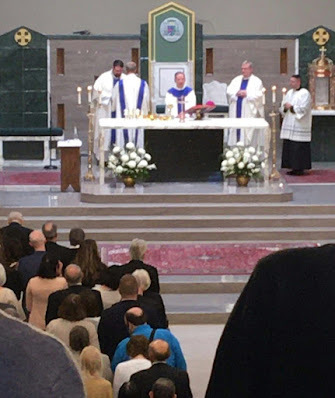 This past Sunday, October 17, Eileen and I participated in the diocesan Mass for married couples celebrating Golden (50 yrs) and Silver (25 yrs) Jubilees at Saint Thomas More Cathedral in Arlington, Virginia.
This past Sunday, October 17, Eileen and I participated in the diocesan Mass for married couples celebrating Golden (50 yrs) and Silver (25 yrs) Jubilees at Saint Thomas More Cathedral in Arlington, Virginia. A LOT of couples came (as you can imagine from what you see in this picture). We didn't mind sitting in the choir loft. It was a beautiful and inspiring event. We are glad we made the effort to make the trip into "the big city."
Bishop Michael Burbidge met with each couple after the Mass too, and was very generous with his time and attention. We are grateful to the Lord for 25 years of living the sacrament of marriage and raising our family in this wonderful diocesan church community.❤️✝️
October 14, 2021
Maria Maria Maria Maria Maria Maria!
Our granddaughter Maria is now three months old, and she's holding her head up. Time for a collage!😉
So alert and curious.☺ But she sleeps a lot too!💟



October 13, 2021
Catholics in the Russian Ritual and Spiritual Tradition
I have been working on an article about the remarkable Russian priest, exarch, and confessor of the faith (perhaps he may even qualify as a martyr) Blessed Leonid Feodorov (1879-1934). Leonid had a great desire, which he began to realize in his own life, of a reconciliation between East and West in which the Russian Church would keep its special charism and its traditional ("Orthodox") modes of worship and Christian living while also recognizing in a fully Catholic way the Pope's leadership of the Universal Church.
I have decided to share some background and contextual notes that were too long for the final cut of the article (which will be published in May 2022) but which expand our understanding of the ecclesiastical, political, and spiritual factors of Father Leonid's world, and how his hope for unity remains vital in our time and points toward the future.
For centuries there have been “Byzantine Catholic” churches that celebrate ancient forms of the liturgy and observe distinctive traditions while also being in union with Rome. For various complicated political and cultural reasons, however, a "Russian Byzantine Catholic" church did not exist in any way until the 20th century, and it had only a brief time before the advent of the atheistic regime of the Soviet Union.
Before 1905, Russians who wanted the fullness of Catholic Christianity had to join Polish or other Western churches, become “westernized” (i.e. adopt an inculturation of the faith that was foreign to them), and face harsh civil penalties. Often, the only possibility for a Russian to even become Catholic was to go into exile. As the 19th century came to an end, Vladimir Soloviev’s experience had already made it clear that anyone who wanted to be both a papist and a follower of Russia’s spiritual traditions would have great difficulties fitting in, or even being understood, in Russia. By recognizing, openly proclaiming, and vigorously arguing for the claims of the papacy, Soloviev—a lay man and virtually on his own—tried to anticipate Christian unity by regarding himself as a "Russian Orthodox in communion with Rome." He found himself in a very isolated and lonely position. Nevertheless, he spoke freely and had a powerful influence on some young people in his personal circle, including the 20-year-old Leonid Feodorov. By the time Soloviev died in 1900, the great philosopher had lit a spark that led to a small movement of “Russian-Rite” Catholics who tried to evade the repressive laws of the Empire.
The upheavals of the 20thcentury, however, changed this situation in dramatic ways. Russia’s 1905 revolution created new possibilities for religious freedom. The overthrow of the Tsar in March 1917 expanded them further, but then the Communist revolution in October 1917 led to a persecution of all religious believers.
This left a small “window” of a few years, during which a remarkable (small but publicly lived) reality appeared in the cities of Moscow and Saint Petersburg: For the first time since the Middle Ages, a Russian Byzantine Catholic Church—in full communion with the Pope—was established, with its thousand-year-old Slavonic Divine Liturgy of the Eucharist, its Liturgical Offices, its traditional chant, its calendar and feast days, and everything that would be found in Russian Orthodox Church worship and life—but with prayers for the Pope of Rome restored to the liturgical intercessions, and juridical communion with Rome secured through the Ukrainian Byzantine Metropolitan of Lviv, the great Andrew Sheptytsky. He had received permission from Pope Pius X to take wide-ranging pastoral responsibility for the small flock of Russian Byzantine Catholics—a few former Russian Orthodox priests and some deeply dedicated lay men and women. In May 1917, Metropolitan Andrew established this group as the Russian Byzantine Catholic Exarchate (a kind of “missionary diocese”) and his friend and protege Father Leonid Feodorov became Exarch (with the authority of a bishop, which he retained even though subsequent circumstances prevented his episcopal ordination). From May to October 1917, the new Russian Byzantine church flourished, and engaged in frank, vigorous, and promising diologue with its Russian Orthodox neighbors.
Exarch Leonid had been raised Orthodox, and he had left Russia to become Catholic but was eventually ordained a priest of the Byzantine rite. He returned to Russia after the changes and began his pastoral ministry. He longed for the rise of a Church that was both fully Russian and fully Catholic. He was convinced that the “Great Schism” of Eastern and Western Christendom in 1054 could only be healed by a reunion that retained Russia Orthodoxy’s distinctive history of sanctity and profound devotion (none of which conflicted with submission to the Pope). In this Leonid anticipated Vatican II and an approach which is common today, but was only beginning to enter the minds of Catholics (with the encouragement of the Popes themselves) and Orthodox at that time.
During these same months in 1917 when the Russian Exarchate was blossoming, the Virgin Mary was appearing to the children of Fatima on the other side of Europe, imploring prayers for “the conversion of Russia.” We will never know what might have happened if Europe had accepted Pope Benedict XV’s Peace Plan issued on August 1, 1917 to end their brutal fratricidal war and turn their hearts to conversion and prayer. Instead, the violence continued, and Russia’s Communist revolution began the horrific era of totalitarian ideologies and the unspeakable crimes committed throughout the world in their name. A century later, we have seen Our Lady’s hand at work in Russia's turning away from Soviet Communism, and we must continue to pray for the fulfillment of her plans for her beloved Russian children.
Exarch Leonid and most of his companions were exiled or sent to the Gulag. Leonid suffered greatly in Solovski in the Arctic, and died shortly after his release in 1934. He was beatified in 2001. A small flock of Russian-rite Catholics survived and remain today in Russia and other parts of the world… a small flock, with a great hope.
October 10, 2021
Christina Grimmie: “With Love”
Five years, four months… We have sorrow but our hope remains firm. And we are full of gratitude that continues to grow. Remembering Christina Grimmie, WITH LOVE!⭐️💚💚💚⭐️
🎶"When I'm down and I'm done /
And I'm coming unplugged /
When I'm ready to fall /
You're the one always holding me up /
With love."🎶

October 9, 2021
Newman and the “Narrow Way”
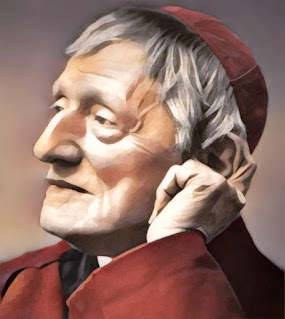 October 9 commemorates Saint John Henry Newman, a.k.a. "Cardinal Newman," the 19th century pioneer of the English Catholic revival. His courageous and deeply human witness has helped bring countless people to Christ's Church (especially in the English speaking world).
October 9 commemorates Saint John Henry Newman, a.k.a. "Cardinal Newman," the 19th century pioneer of the English Catholic revival. His courageous and deeply human witness has helped bring countless people to Christ's Church (especially in the English speaking world)."What shall bring us forward in the narrow way, if we live in the world, but the thought and patronage of Mary.... She will comfort us in our discouragements, console us in our fatigues, raise us after our falls, reward us for our successes. She will show us her Son, our God and our all" (Saint John Henry Newman).
October 8, 2021
The Beginning of the "New Media" Technological Revolution
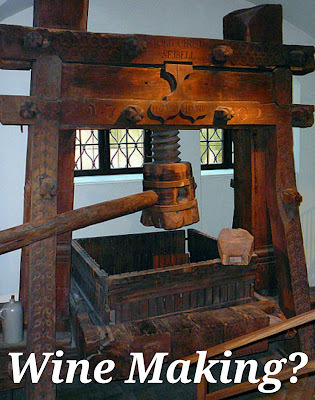 Media technology has been around for longer than we might think. Historically, it has brought about a series of explosions in the scope and proliferation of capacities for communication. It is worth considering these events, and recalling the rapid, transformative impact they had on personal and social life.
Media technology has been around for longer than we might think. Historically, it has brought about a series of explosions in the scope and proliferation of capacities for communication. It is worth considering these events, and recalling the rapid, transformative impact they had on personal and social life. The original technological revolution in media evolved slowly for many centuries, until it "came together" within a particular social context and rapidly became a global phenomenon. Hundreds of years later, this form of media is so established that few people could imagine life without its pervasive presence and activity.
Human "extension" through communications media corresponds to the interactive nature of human persons with one another within the possibilities of their environment. We see this dynamic at work in a way that is complex and intricate yet seems almost "spontaneous" to the maturation of ordinary human life when we consider the use of languages, and their development and continuance in the various histories of human communities. I'm not sure if spoken languages fall under the category of "media," as they are so proximate and intimate to structures of human expression. At the same time, they are a system of sounds and gestures that we learn from others ("naturally" in the environment of our "mother tongue") so that we can express ourselves, discuss ideas, formulate conclusions, and reveal our intentions to one another.
More "mediation" occurs when we move one step "away" from spoken words and generate visual symbols to represent words and statements. There have been human communities that use elaborate spoken languages but have no written language, and - or course - for most of human history the written languages that did exist were only accessible to a very small percentage of the population. Yet this basic media form permitted human communication to extend itself through space and time. Ancient civilizations can "communicate" with us even today, insofar as we are able to comprehend the linguistic symbols they wrote and that have been passed on to us.
Writing was a delicate craft, that became more common and more influential along with the materials that made it easier and more durable - from chiseled stone tablets to more lightweight, portable, flexible materials like animal skins, bamboo, papyrus, etc. that could sustain and preserve long-lasting marks applied by natural staining agents, like ink. Writing enabled societies to have sophisticated legal systems, government networks, and more extensive trade. It also transformed stories and many forms of public discourse into a new thing: Literature.
Nevertheless, this had little impact on the daily life of the average (illiterate) person.
What was needed for writing to permeate the whole social communications environment was some method to multiply exponentially the copies of a written text. It seems that the needs and interests of societies played a significant role in the development of "writing technology." The Chinese invented paper sometime in the first millennium, and the (effective though also labor intensive) technique of wood block printing existed by the 7th century (early in the Tang Dynasty). Large scale reproduction and distribution of texts began, which may have had an impact by broadening the possibilities for more people to have access to the "literate class. " It also helped expand, unify, and render more efficient the Imperial bureaucracy of the Tang and Song dynasties, and it fostered the expansion of Buddhism through the distribution of translated Buddhist texts (both Chinese and Korean). Still, classical Chinese writing involved an erudite, exacting and aesthetically beautiful arrangement of over a hundred thousand ideograms. It produced an incomparably great tradition of poetry and literature, and was useful to communications specialists throughout society, but its complexity may have prevented it from becoming an expressive medium for ordinary people in the wider spectrum of life's circumstances.
The Song dynasty was overthrown finally by Kublai Khan in the 13th century, but printing continued. The Mongols - great invaders and destroyers, but also appropriators of the cultures that submitted to them - likely brought printing with them throughout their vast Empire. Chinese and Koreans had already pioneered movable type by this time. Marco Polo records his astonishment at the use of "paper money" throughout Kublai Khan's realms.
It's not unlikely that - via the Mongol invasions as well as the trade on the Silk Road - paper and print techniques spread from China and East Asia to the Islamic world and to Europe. Here printing met the phonetic-based alphabets, which not only had a peculiar simplicity; they also directly symbolized the "sounds" of speech, which implied that in principle anyone who could speak could learn to read and write without necessarily possessing the specialized erudition of Chinese scholars and bureaucrats. While Muslims were printing editions of the Qu'ran by the 14th century, we find in Europe at first a great deal of designs reproduced, and various accessory items like decks of cards. It was only when the desire for learning overflowed from the great medieval universities and extended to other social classes (i.e. the Renaissance) that Europeans felt the need for texts in a way that monastic and university copyists could not provide.
It was inevitable that a spark would come to ignite the fire that would change the history of humanity. But the clever and tenacious goldsmith of Mainz - Johannes Gutenberg - probably didn't realize the enormous scope of the first "New Media" revolution that his "printing press" would initiate. Gutenberg refined movable type and combined it with the basic mechanical technology used for pressing grapes for wine and olives for oil (thus the term "press" acquired a new meaning, and to this day it remains a central metaphor for print media). We know little about Gutenberg himself, other than the fact that he printed a famous Bible and died in 1468. But the fetters had been lifted from the printed word, and - as we say in the 21st century - it "went viral."
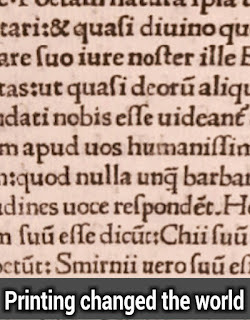 Pamphlets and books flooded Europe in the 16th century. Print and "publication" became a reality within the human environment, an available modality of communication within reach of everyone who could read (and unprecedented numbers of people learned to read). With the printed word came also a flood of ideas - good ideas and bad ideas - which is a whole story in itself, the volcanic story of change that set the stage for "the modern world" and for the emerging epoch of our time.
Pamphlets and books flooded Europe in the 16th century. Print and "publication" became a reality within the human environment, an available modality of communication within reach of everyone who could read (and unprecedented numbers of people learned to read). With the printed word came also a flood of ideas - good ideas and bad ideas - which is a whole story in itself, the volcanic story of change that set the stage for "the modern world" and for the emerging epoch of our time.Digital technology has flipped us over to new audiovisual modes of communicating, but it has also expanded further the reach of print, or at least the "visual" presentation of print. The "image" is on the rise in today's modes of communication, but the original Media Revolution that filled the world with printed words and made us all readers and writers is not over yet. Indeed, digital image technology has facilitated the "virtual" crafting of typefaces of all kinds, accessible to anyone, that can appear on paper with the click of the print key.
Even though there is no paper edition of this blog, what I am writing here and now still draws on what Marshall McLuhan called "The Gutenberg Galaxy."
More on this topic coming soon....
October 7, 2021
The Rosary: "His Abundant Mercy From Age to Age"
October 7: Our Lady of the Rosary.
Original Digital Artwork by JJ. Text from the Preface to the Eucharistic Prayer for today's Liturgy.

October 6, 2021
Assisi: All of Life is a Pilgrimage
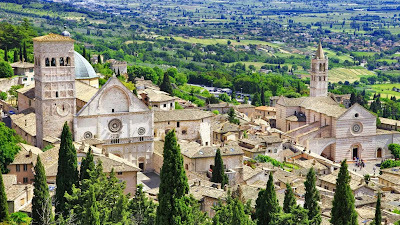 Having begun this week with the celebration of Saint Francis of Assisi, I was moved to read a relevant section in one of my old handwritten journals. It's hard to believe it was 25 years ago that Eileen and I spent three and a half weeks in Italy for our honeymoon in June and July 1996. That unforgettable trip was many things: the beginning of our married life; a great series of adventures we had together; a chance to make common memories in places where we had both previously lived (separately and at different times); an exploration of history, art, and architecture; a series of wonderful meals; many reunions with Italian friends from Rome to Liguria; and of course lots of wrong turns, hassles, inconveniences, exhaustion, and fun. But above all it was a pilgrimage.
Having begun this week with the celebration of Saint Francis of Assisi, I was moved to read a relevant section in one of my old handwritten journals. It's hard to believe it was 25 years ago that Eileen and I spent three and a half weeks in Italy for our honeymoon in June and July 1996. That unforgettable trip was many things: the beginning of our married life; a great series of adventures we had together; a chance to make common memories in places where we had both previously lived (separately and at different times); an exploration of history, art, and architecture; a series of wonderful meals; many reunions with Italian friends from Rome to Liguria; and of course lots of wrong turns, hassles, inconveniences, exhaustion, and fun. But above all it was a pilgrimage. Indeed, Italy — if one really pays attention — is a powerful symbol of the truth that all of life is a pilgrimage, a journey that ultimately transcends the limits of this world but also encompasses and illuminates all that is good and lovely and meaningful in all the moments and facets of temporal life.
It's hard to believe that we have not been to Italy since that trip. Our three adult children have been there, and the others will probably go during their university studies. I hope that Eileen and I can return some day, to visit again these important and enduring places (and see our friends once again in their homes). In any case, these days — a quarter of a century ago — never feel "very far away" from us. In a way, they laid the foundations for our journey together as husband and wife, our common vocation as educators, our home, and our family life. They helped give concrete shape to our pilgrimage in this world during these last 25 years, and will continue to be vitally important to us for engaging the times to come.
In honor of Saint Francis, I am reproducing below a brief excerpt from my journals regarding our arrival in Assisi. As you will see, I was incurably brainy, even during our honeymoon.😜 Ah well, that's one of the things Eileen has always loved about me, even when — as is often the case — it is more a burden than a talent. She has always helped me to bear it.
"After a week and a half in Rome, we left early on this morning for a new destination in our pilgrimage — Assisi. As the train climbed into the Umbrian hills, we immediately sensed the change in atmosphere. We were leaving the chaos, the noise, and the contradictions (as well as the spiritual and historical vastness) of Rome, and entering into a place of quiet and simplicity of focus.
"Rome is the second greatest place of pilgrimage in all the world (second only to Jerusalem and the Holy Land), but it is also many other things: tourist center; historical, archaeological, and artistic center; economic and political center; and now also — in these most recent years — immigration center. The proportions of Rome are everywhere huge: supernatural grandeur, human grandeur, but also "splendid vices" and — today especially — ever enlarging tunnels of physical and personal misery. Assisi is something markedly different. Assisi is a place of pilgrimage ... and nothing else.
"The first thing that struck me in the train station and that continued to strike me throughout the visit is that everyone visits Assisi as a pilgrim. This does not mean that everyone knows why they have come here. But the whole of Assisi is centered upon one thing, and everyone comes here on account of that one thing. That "one thing" is a man. One man who lived 800 years ago. One human being who fascinates everyone.
"Indeed, every saint generates fascination; it is of the nature of a saint to fascinate (because holiness is true and good and beautiful). But Francis fascinates like no one else. He remains a living icon of Christ and a living icon of the human vocation in its purest and most transparent form, which is simply to love, to love "without measure," to love "madly" — indeed, it is to love without measure because the Beloved is immeasurable, to love madly because the Beloved is good and beautiful beyond every limit of human calculation.
"We had all of our baggage with us, so we stayed in a small hotel right across the street from the train station, at the foot of the hill where the medieval town rises up to the sky. The window of our room had a perfect view of Assisi. After checking in, we went immediately up the hill (in a bus) to the Basilica of San Francesco, where we attended the high Mass and then visited the crypt, which holds the tomb of Saint Francis surrounded by the tombs of his first and most beloved brothers. I was struck by the power and the palpability of the affection of this most extraordinary companionship of the 'first Franciscans.'
"Above all, however, I was amazed by the pilgrims. They prayed at the tomb, kissed the ground in front of it, pressed their heads against the grating in order to draw closer, as though they could perhaps rest their heads in the bosom of Francis. Nowhere did I see mere curiosity. Hearts were exposed here, the unfathomable human desire was wrestling its way forward to the surface of those faces that crowded around Saint Francis in the tiny crypt."
~Sunday, July 7, 1996



